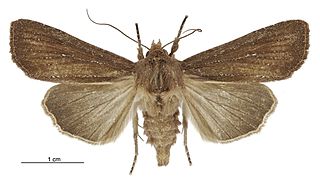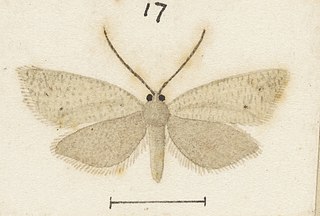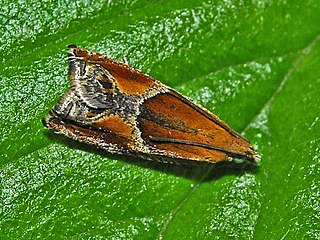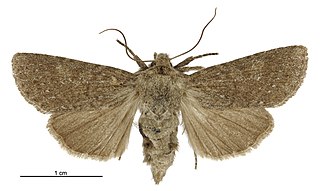
Asterivora colpota is a moth in the family Choreutidae. It was first described by Edward Meyrick in 1911. It is endemic to New Zealand and is found throughout the North and South Islands. It is regarded as a lowland species and adults are on the wing from November until March. This moth has been collected by beating shrubs.

Asterivora iochondra is a species of moth in the family Choreutidae. It is endemic to New Zealand and was first described by Edward Meyrick in 1911. This species has been observed in both the North and South Island at Mount Holdsworth and Mount Arthur. This species inhabits open spaces on mountains on the forest edge at 3000 ft altitude. Adults of this species are on the wing in February and flies rapidly in sunshine.

Heterocrossa eriphylla, also known as the lichen snoutlet moth, is a species of moth in the family Carposinidae. It is endemic to New Zealand and is found in the North Island and the northern parts of the South Island. This species is regarded as relatively uncommon and inhabits native forest. The larvae feed on the healing wounds of New Zealand beech trees Fuscospora fusca and Fuscospora truncata. It pupates at its feeding site and emerges from December onward. The adult moth is nocturnal and is attracted to light. During the day the moth rests on lichen covered tree trunks where their lichen mimicking colouration assists with their camouflage.

Heterocrossa gonosemana is a species of moth in the family Carposinidae. It is endemic to New Zealand and is found throughout the country. It inhabits native forest. Larvae feed on seeds and fruit of Griselinia lucida and possibly Griselinia littoralis. They can be extremely active when disturbed. This species overwinters as a pupa, enclosed in a cocoon, underneath its host plant. Adults are on the wing from November until February and can be found during the day resting on lichen covered tree trunks where they are well camouflaged. The adult is nocturnal and is attracted to light.

Ichneutica scutata is a moth of the family Noctuidae. It is endemic to New Zealand. This species can be found in the southern parts of the North Island as well as the eastern parts of the South Island. It is similar in appearance to I. insignis and I. skelloni but can be distinguished as I. scutata is much paler in appearance. It is likely this species inhabits lowland tussock grasslands as well as coastal dunes although it is not common in inland tussock grasslands. The larvae feed on a variety of herbaceous plants such as Plantago and Convolvulus species, Plagianthus divaricatus. It pupates on soil near its host plants. The adults are on the wing from late March to July.

Ichneutica micrastra is a moth of the family Noctuidae. It is endemic to New Zealand. This species has been found only in the North Island and has been collected in the Northland, Auckland, Whanganui and Wellington regions. The preferred habitat of this species is wetlands and heathlands including gum fields in Northland. Adults of this species are on the wing from October to December. The life history of this species is unknown as are the host species of its larvae however it has been hypothesised that the likely larval host is a grass or grass like plant. This species is very similar in appearance to I. phaula and I. sapiens but can be distinguished as a result of differences in male antennae, the shape, colour and size of forewings, the range of the species as well as differences in genital shape.

Ichneutica steropastis, or the flax notcher moth, is a species of moth in the family Noctuidae. It is endemic to New Zealand and can be found throughout the country from the Three Kings Islands to Stewart Island as well as in the Chatham Islands. The larvae of this species feed on a variety of native and introduced plants however the New Zealand flax is one of the more well known host plants for the larvae of this moth. The larvae are nocturnal, hiding away in the base of the plants and coming out to feed at night. They create a distinctive notch in the leaf when they feed. The adults of this species are on the wing from October to March. Although adult specimens of I. steropastis are relatively easy to recognise they might possibly be confused with I. inscripta, I. theobroma or with darker forms of I. arotis. However I. steropastis can be distinguished as it has a long dark basal forewing streak that these three species lack.

Apoctena taipana is a species of moth of the family Tortricidae. It is endemic to New Zealand and has been observed in both the North and South Islands. The larvae created a silken tube in which they hide and also use to travel from leaf to leaf. They tunnel into the leaves of their host. Larvae can be found from June to August. Adult moths can be seen on the wing from October to January.

Ecclitica torogramma, also known as the ponga ugly nestmaker, is a species of moth of the family Tortricidae. It is endemic to New Zealand.

Ericodesma aerodana is a species of moth of the family Tortricidae. It is endemic to New Zealand and is found in the North and South Islands. The species inhabits sand dunes and larvae feed on Pimelea prostrata. Adults are on the wing from October to January and are active at twilight. This species is classified as "At Risk, Declining" by the Department of Conservation as its larval host plant is under threat from habitat loss and the invasive to New Zealand plant, sea spurge.

Epichorista aspistana is a species of moth of the family Tortricidae. It is endemic to New Zealand and has been collected in Canterbury and Otago. This species inhabits moist grassy areas at altitudes ranging from sea level to 1650m. Larvae feed on species within the genus Acaena. Adults are on the wing in November to February.

Ancylis obtusana, the small buckthorn roller, is a moth of the family Tortricidae.

Ichneutica paraxysta is a moth of the family Noctuidae. It is endemic to New Zealand. This species is very similar in appearance to its close relative I. acontistis but as the range of the two species do not overlap this is unlikely to cause confusion. I. paraxysta is only found in the North Island at the subalpine zones in the Mount Taranaki region and at Mount Ruapehu. It prefers tussock grassland and shrubland habitat. The life history of this species is unknown as are the host species of its larvae however it has been hypothesised that the larval host plants are species in the genera of Poa and Festuca.
Pammenemima ochropa is a moth of the family Tortricidae first described by Edward Meyrick in 1905. It is found in Sri Lanka and its Barberyn Island.
Dasodis microphthora is a moth of the family Tortricidae first described by Edward Meyrick in 1936. It is found in Sri Lanka, Java and the western Caroline Islands.
Cryptaspasma brachyptycha is a moth of the family Tortricidae first described by Edward Meyrick in 1911. It is found in Sri Lanka and Australia.

Maurilia iconica is a moth of the family Nolidae first described by Francis Walker in 1857. It is found in Indo-Australian tropics of Sri Lanka, Australia to the islands of Samoa, Rarotonga and New Caledonia.

Ichneutica sollennis is a moth of the family Noctuidae. This species is endemic to New Zealand. This species is known from the eastern and central areas of the southern South Island. It inhabits alpine zones and has been collected in tussock grasslands. The life history of this species is unknown. Although the host species is currently unknown it has been hypothesised that this species have grass or grass like plants as host plants. Adults are on the wing from November to February and are attracted to light.

Asaphodes prymnaea is a moth in the family Geometridae. It is endemic to New Zealand and can be found on the Mount Arthur tableland. It is common in limestone valleys. The female of the species is paler and has less distinctive markings than the male. Adults are on the wing in January and February.

Holocola charopa is a species of moth in the family Tortricidae. It was first described by Edward Meyrick in 1888. It is endemic to New Zealand and has been observed in the northern parts of the North Island. The larvae web together and feed on the new shoots of their host plant Kunzea ericoides. Adults are on the wing in July and from November until February.
















